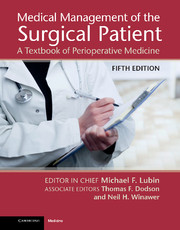Book contents
- Frontmatter
- Dedication
- Contents
- List of Contributors
- Preface
- Introduction
- Part 1 Perioperative Care of the Surgical Patient
- Part 2 Surgical Procedures and their Complications
- Section 17 General Surgery
- Section 18 Cardiothoracic Surgery
- Section 19 Vascular Surgery
- Section 20 Plastic and Reconstructive Surgery
- Section 21 Gynecologic Surgery
- Section 22 Neurologic Surgery
- Section 23 Ophthalmic Surgery
- Section 24 Orthopedic Surgery
- Chapter 116 Arthroscopic knee surgery
- Chapter 117 Total knee replacement
- Chapter 118 Total hip replacement
- Chapter 119 Fractures of the femoral shaft
- Chapter 120 Hip fractures
- Chapter 121 Lumbar spine surgery
- Chapter 122 Surgery for adult spinal deformity (scoliosis or kyphosis)
- Chapter 123 Cervical spine surgery
- Chapter 124 Surgery of the foot and ankle
- Chapter 125 Lower extremity amputations
- Chapter 126 Surgical procedures for rheumatoid arthritis
- Section 25 Otolaryngologic Surgery
- Section 26 Urologic Surgery
- Index
- References
Chapter 118 - Total hip replacement
from Section 24 - Orthopedic Surgery
Published online by Cambridge University Press: 05 September 2013
- Frontmatter
- Dedication
- Contents
- List of Contributors
- Preface
- Introduction
- Part 1 Perioperative Care of the Surgical Patient
- Part 2 Surgical Procedures and their Complications
- Section 17 General Surgery
- Section 18 Cardiothoracic Surgery
- Section 19 Vascular Surgery
- Section 20 Plastic and Reconstructive Surgery
- Section 21 Gynecologic Surgery
- Section 22 Neurologic Surgery
- Section 23 Ophthalmic Surgery
- Section 24 Orthopedic Surgery
- Chapter 116 Arthroscopic knee surgery
- Chapter 117 Total knee replacement
- Chapter 118 Total hip replacement
- Chapter 119 Fractures of the femoral shaft
- Chapter 120 Hip fractures
- Chapter 121 Lumbar spine surgery
- Chapter 122 Surgery for adult spinal deformity (scoliosis or kyphosis)
- Chapter 123 Cervical spine surgery
- Chapter 124 Surgery of the foot and ankle
- Chapter 125 Lower extremity amputations
- Chapter 126 Surgical procedures for rheumatoid arthritis
- Section 25 Otolaryngologic Surgery
- Section 26 Urologic Surgery
- Index
- References
Summary
The hip joint is a constrained ball and socket joint capable of withstanding repeated forces in excess of ten times body weight. The articulating surfaces of the femoral head (the ball) and the acetabulum (the socket) are covered with articular cartilage which allows smooth and painless motion. Pain, stiffness, and declining function due to cartilage and bone damage in the hip joint are the primary indications for total hip arthroplasty. Most commonly, these symptoms are the result of osteoarthritis, but can also occur with inflammatory arthritis (e.g., rheumatoid arthritis), bone death (e.g., avascular necrosis) or the sequelae of traumatic injury (e.g., previous fracture). It is now recognized that most cases of hip osteoarthritis are a result of subtle variations in the shape of the femoral head and/or acetabulum. These variations result in hip impingement (abnormal contact forces across the joint that eventually result in destruction of articular cartilage).
When the symptoms of hip arthritis are no longer responsive to conservative measures including medication and reduction in hip joint force (e.g., weight loss or use of a cane), total hip arthroplasty may produce dramatic improvements in pain management, function, and quality of life. The operation is performed through an incision over the outside of the hip. The joint is exposed and an osteotomy (bone cut) in the femoral neck allows removal of the femoral head from the acetabulum. The acetabulum is prepared to accept a hemispherical metal socket. A hemispherical socket liner is then snapped into the socket. The hollow canal of the femur bone is prepared to accept a metal stem. A ball that perfectly matches the shape and size of the liner of the socket is attached to the top of the stem. The soft tissues around the hip are then repaired and protected while they heal.
- Type
- Chapter
- Information
- Medical Management of the Surgical PatientA Textbook of Perioperative Medicine, pp. 718 - 720Publisher: Cambridge University PressPrint publication year: 2013

